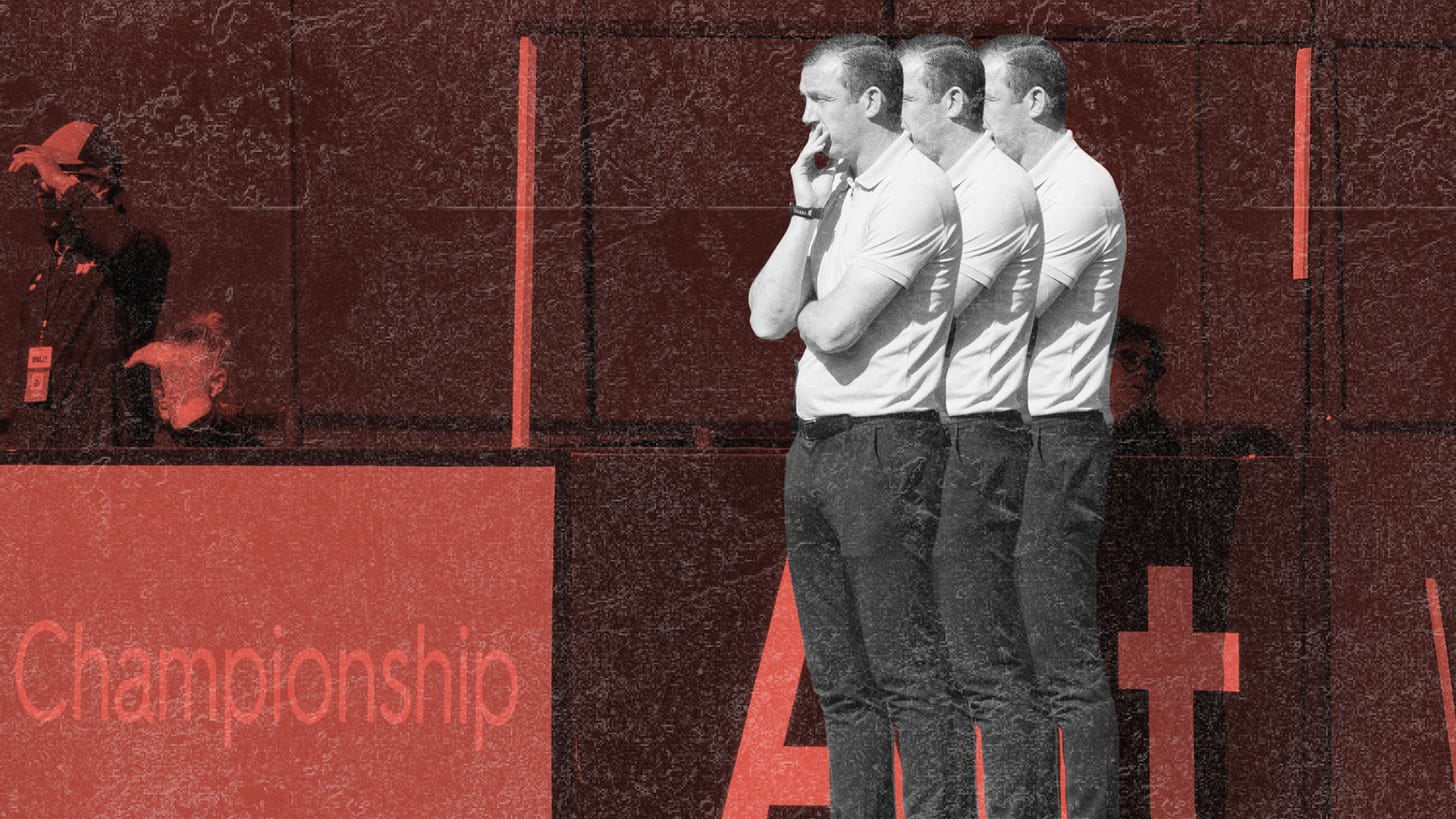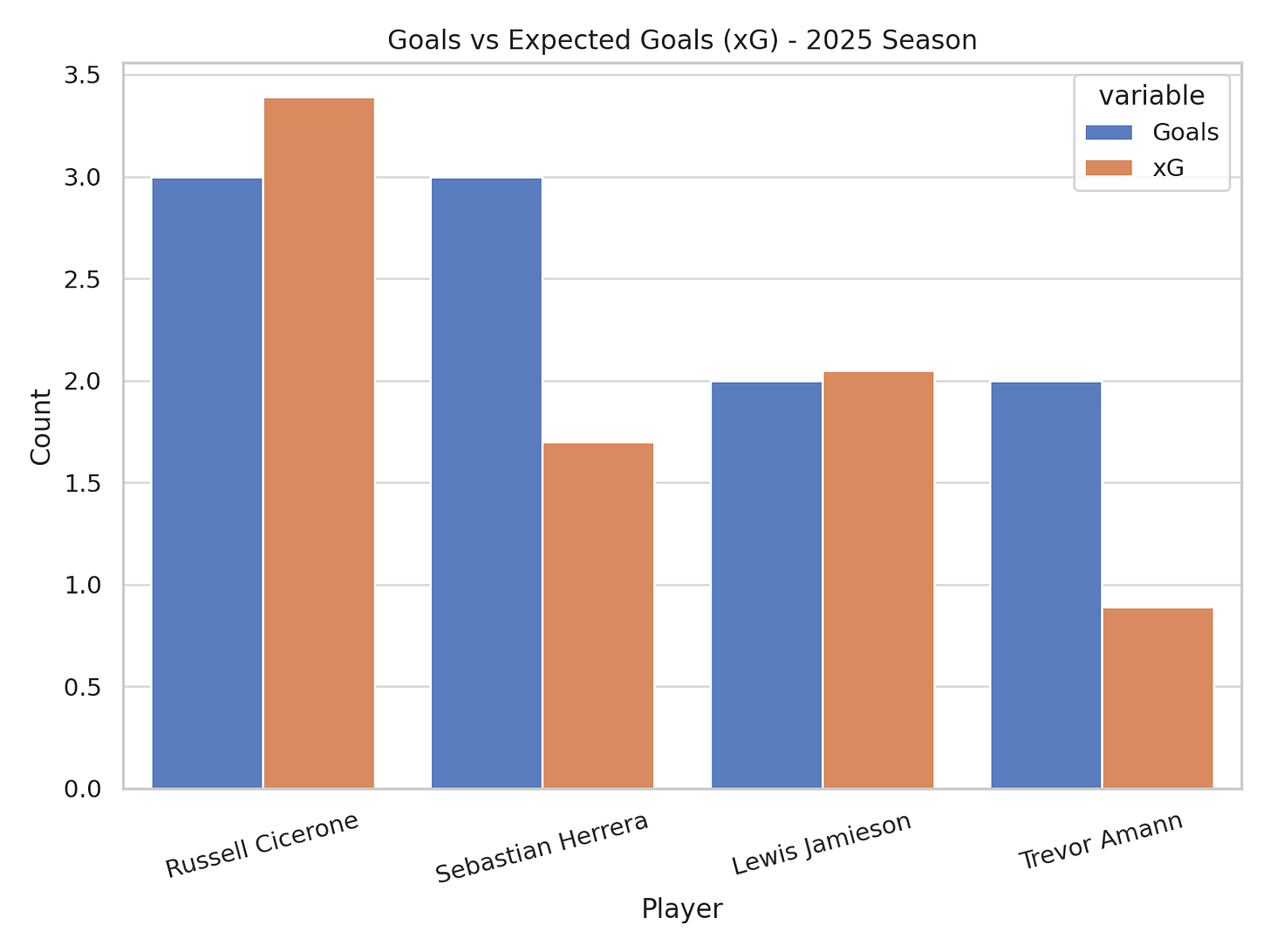Still Toothless: Republic FC’s Attack Has Become a Liability
Despite strong defensive structure, Sacramento Republic FC’s lack of goals and tactical stagnation leave them far from title contention.
For all the talk of tactical progress and a new era under head coach Neill Collins, one undeniable truth continues to define Sacramento Republic FC’s 2025 campaign: this team simply cannot score.
With 15 goals through 12 matches, the Republic sits near the league average in production — not awful, but far from what’s expected of a club with top-four ambitions. And when you look past the surface, the picture gets even bleaker. Sacramento’s expected goals (xG) suggest they should be closer to 21 goals by now. They aren’t. That’s a shortfall of nearly four goals — and in a league where margins are razor-thin, those missing goals are the difference between contending and chasing shadows.
In a season where Sacramento’s defense has remained organized and the midfield has controlled possession more often than not, it’s the final third — again — where everything breaks down. And at this point, it’s no longer a blip. It’s an identity.
The Numbers Say What the Eye Already Sees
By the numbers, Sacramento has taken 137 shots this season — but only 39 have been on target. That’s a troubling 28% shot accuracy rate. Worse, just 15 of those chances have found the back of the net, which falls far short of the roughly 19 goals expected based on shot quality.
This isn’t just poor luck or a few missed sitters — it’s a systemic failure to turn possession into production. The Republic aren’t getting unlucky; they’re underdelivering.
Just as damning: only nine of those 15 goals have been assisted. That means nearly half of Sacramento’s goals have come from individual effort, second balls, or moments of chaos rather than structured, intentional play. It’s a glaring sign that the system isn’t creating clean, repeatable paths to goal — and that’s on the manager.
Cicerone, Herrera, and a Broken Formula
Russell Cicerone and Sebastian Herrera currently lead the team with three goals apiece. On paper, that looks balanced. In practice, it reveals a much deeper problem.
Cicerone, the team’s highest-rated attacker at 7.20, is producing exactly what the analytics expect — 3.39 xG, three goals. He’s dependable, works hard off the ball, and consistently finds himself in good areas. But for a forward with his workload, he needs to be doing more than just hitting the mean. He needs to be lifting it.
Herrera, on the other hand, has overperformed his xG (1.70) with three goals of his own, but his influence outside the scoresheet has been minimal. A 6.53 player rating tells the story: Herrera scores, but does little else to link play or create for others.
Perhaps the most telling stat of all is what happens when the two of them share the pitch. When only one of them starts, Sacramento scores more goals per match than when both are in the lineup together. Instead of amplifying each other’s strengths, their partnership seems to cancel out space and congest the attack — a tactical misfire that’s been allowed to linger.
Who’s Actually Earning Their Minutes?
While the established frontmen continue to start, it’s Sacramento’s bench that has quietly outperformed expectations. Forward Trevor Amann has scored two goals in just 49 minutes. Yes, the sample size is small, but a 3.67 goals-per-90 rate deserves at least a few more chances to prove it’s real.
Lewis Jamieson has also shown flashes, contributing two goals in under 400 minutes — a more-than-respectable 0.45 goals per 90. These aren’t earth-shattering numbers, but when compared to the output of players like Cristian Parano — one goal in 776 minutes despite 20 shots — they speak volumes.
And yet, neither Amann nor Jamieson can get a consistent look. Whether that’s due to trust, tactical fit, or rotation philosophy, it’s a coaching decision that looks increasingly questionable. If the offense is stalling, why are the few players scoring goals watching from the sideline?
Possession Without Purpose
Statistically, Republic FC doesn’t look like a struggling team. They average over 51% possession and boast solid passing numbers, including nearly 68% accuracy in the opponent’s half. But those numbers lose all meaning if they don’t lead to danger.
Possession has become Sacramento’s comfort zone — a place to pass, recycle, and maintain shape. But it’s not a launchpad for goals. In the attacking third, there’s a clear lack of risk-taking, urgency, and movement. The midfield doesn’t create clear chances, the wings don’t stretch defenses, and the strikers look increasingly stranded.
Rodrigo Lopez has just one assist all year. Luis Felipe and Blake Willey have none. For a team that wants to build from the back and control games, the inability of its midfield to generate even average levels of production is not a flaw — it’s a crisis.
So What Now? The Pressure Is Building
With goals drying up and results becoming harder to come by, pressure is mounting — not only on the players, but on the leadership responsible for setting the team’s direction.
The offseason signing of Neill Collins was a statement. Sacramento Republic FC paid a buyout fee to lure the Raith Rovers head coach after the mutual departure of Mark Briggs. The move signaled belief in Collins’ long-term vision — a bet on possession, structure, and adaptability. But after the worst start in club history and a three-match scoreless run not seen since 2022, that bet is under scrutiny.
Collins has yet to find a formula that consistently works in the final third. The attack feels disjointed. Tactical flexibility has been minimal. And when goals are this hard to come by, repetition without results becomes harder to justify.
At the same time, General Manager Todd Dunivant deserves renewed evaluation. The squad lacks balance. There’s no clear No. 10 pulling strings, and the forward group — while capable — hasn’t produced at the level needed. If the system doesn’t fit the roster, is that a coaching issue, or a recruitment one?
So what happens now?
First, a tactical reset.
If Sacramento is going to dig itself out, it can’t keep rolling out the same ideas hoping for different outcomes. The team may need to step away from the dual-forward approach that hasn’t yielded returns. Sacramento could benefit from simplifying its attack: focus on more direct play, move the ball quicker into dangerous areas, and prioritize getting players like Jamieson and Amann into more minutes — they’ve earned it. There’s a need to find rhythm, not just structure.
Midfield roles also need rethinking. If Rodrigo Lopez isn’t going to dictate games, someone else must be empowered to do it. Whether that means adjusting shape or shifting player responsibilities, the current setup isn’t maximizing what this roster has.
Second, smart summer reinforcements.
The transfer window offers a lifeline — but only if used wisely. This team needs more than depth — it needs difference-makers. That could mean a striker who brings movement and end product, or a creative midfielder who can control tempo and link lines. Possibly both. It’s clear the team is a few key pieces short of being a threat in the West. That gap can be narrowed, but it will take decisive action.
This Team Is Not a Contender — Not as It Stands
At this point in the season, there’s little ambiguity left. Sacramento Republic FC is not a contender in its current form. The defense has held up. The midfield controls possession. The structure is there. But without a reliable, cohesive attack, none of it matters.
This isn’t about panic or overreaction. It’s about the reality on the field. The team has scored just 15 goals in 12 matches. It’s gone three straight games without finding the net. And it’s failed to show meaningful tactical progress in the final third. For a club with Sacramento’s ambition — and the investment made in its coaching staff — that’s not good enough.
To get back on track, the club must confront what’s not working and move swiftly to fix it. That means making honest evaluations about the system, the personnel, and the leadership guiding both. It means accepting that what’s worked in the past may no longer be enough in a league that keeps evolving.
If the right adjustments are made — tactically and in the transfer market — there’s still time to turn the season around. But until then, Republic FC isn’t chasing a title. It’s chasing answers.
What do you think needs to change first — tactics, personnel, or leadership? Drop your thoughts in the comments and join the conversation.





I think you highlight several of the major shortcomings, but I also see a team that isn’t incredibly hard to play against. I can hardly recall any smart tactical fouls, no bone crunching (clean) tackles or anyone with a fiery attitude that tells opponents we won’t be f’d with. I appreciate beautiful football, but at this point, I would give up some of the pretty play for an ugly goal or two.
The main core from the US Open Cup Final run, are underperforming. I used to look forward going to matches, but this team is boring. It’s been a decline for the past season and a half. For me personally, it was the Western Conference Final vs Phoenix when this started. Being a goal up and parking the bus for a majority of the match was something this fanbase was not used to. Last season was just not good enough. This season is worse. I’m getting bored with three in the back. I’d rather see another midfielder. I watch other teams with creative players and wonder why we don’t.